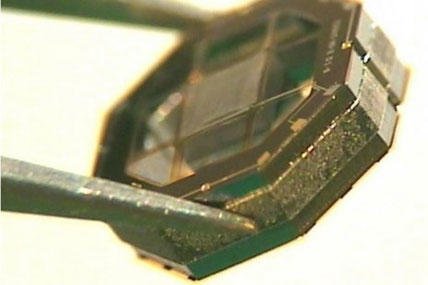ABERDEEN PROVING GROUND, Md. -- The U.S. Army has begun the final phase for manufacturing a microchip-sized prototype that will support efforts to provide highly accurate location and battlefield situational awareness for the dismounted Soldier, even in the temporary absence of GPS capability.
The U.S. Army Research, Development and Engineering Command's communications-electronics RD&E center, CERDEC, hosted Phase II kickoff meetings for manufacturing prototype units of a Chip Scale Atomic Clock, or CSAC, Sept. 26-27.
The goal is to provide complete atomic clock capabilities for weapons, weapon systems and the dismounted Soldier, and to do this with low power and drastically reduced cost, noted John Del Colliano, chief for the Positioning, Navigation and Timing branch of CERDEC's Command, Power & Integration directorate.
"An atomic clock, which is recognized for its accuracy, is used by the military in larger systems; however, the typical atomic clock is large, heavy and requires lots of power. Large systems/platforms like bombers have the advantage of having more power and space to accommodate a full-scale atomic clock, but that's not true for a Soldier on the battlefield or for munitions being fired," Del Colliano said.
The CSAC, which is approximately 15 cubic centimeters, could be integrated into a platform, weapon or a device worn by a Soldier and will be completely transparent to the user, said Paul M. Olson, acting associate director, Systems Engineering, for CERDEC CP&I.
"The CSAC is a critical tool for systems that require very accurate time synchronization, such as communication, navigation, radar and weapon systems. When used in conjunction with other sensors, the CSAC can help these systems provide highly accurate location and battlefield SA to units and commanders," Olson said.
"If GPS is disrupted or jammed, a CSAC could provide precise time to the GPS receiver to enable rapid recovery or to protect receivers from GPS spoofing, a condition where false GPS signals are broadcast to fool GPS receivers with erroneous information. The hope is that the Soldier wouldn't even know that his GPS is being jammed," Olson said.
Initiated by the Defense Advanced Research Projects Agency, the CSAC Manufacturing Technology Objective is jointly funded by the Army, the Air Force Global Positioning System Directorate and the Office of the Secretary of Defense.
CERDEC CP&I serves as the lead, managing the ManTech program; in addition to supporting the technical development and requirements verification, the organization tested the prototypes to prove their capability.
Three vendors have been awarded contracts and are set to deliver a total of 500 prototype units. CERDEC CP&I hopes each vendor will eventually be able to produce more than 20,000 units a year, in the price range of $300 or less. Multiple vendors would significantly reduce acquisition cost for joint service applications requiring precision timing subsystems in Soldier communication systems.
"Flooding the market" is good for the DoD and could lead to CSAC availability in the commercial sector, Del Colliano said.
"Some atomic clocks can be in the $10,000 range. You're not going to put something that expensive in a disposable piece of equipment; however, you can put a $300 component into a piece of equipment that's going to explode," Del Colliano said.
CERDEC CP&I, who works closely with other elements across the DoD, hopes to produce enough units for user evaluation across the DoD, the Dept. of Homeland Security and the Federal Aviation Administration.
"We want to get the message out DoD-wide regarding what's going to become available within the next two years," Del Colliano said. "This is bigger than just the Army; we see this product aiding everyone across DoD."
This is the third and final year of the ManTech effort. Upon completion, CERDEC CP&I is scheduled to transition the CSAC prototype units to Product Director Positioning, Navigation and Timing in September 2013.






























